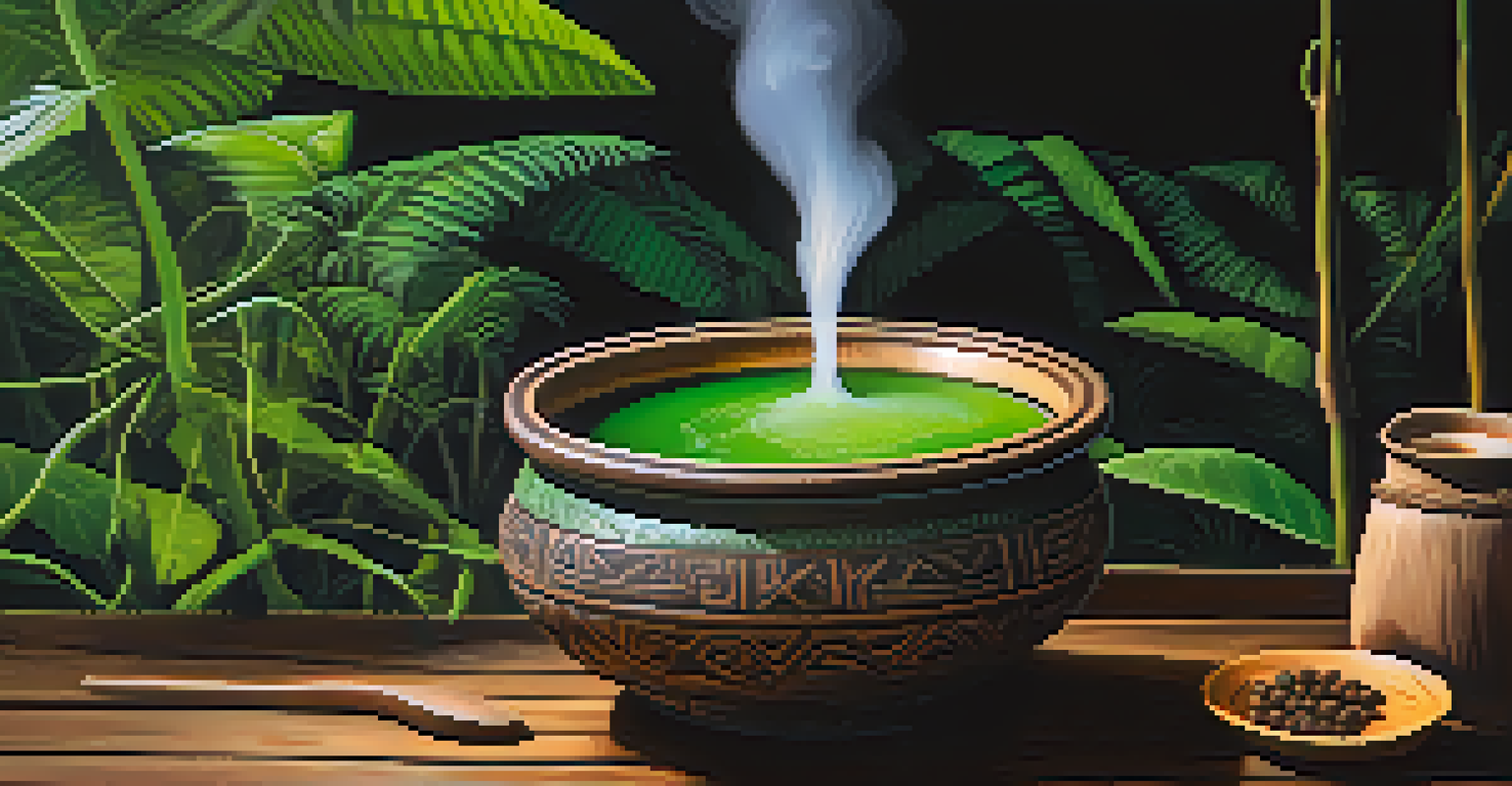Exploring Ayahuasca: A Pathway to Non-Dual Awareness

What is Ayahuasca and Its Cultural Significance?
Ayahuasca is a traditional Amazonian brew made from the Banisteriopsis caapi vine and the Psychotria viridis leaf. This powerful concoction has been used for centuries by indigenous tribes for spiritual and healing purposes. The significance of Ayahuasca in these cultures extends beyond mere recreation; it serves as a profound tool for connection with the divine and for exploring the depths of one's consciousness.
The journey of a thousand miles begins with one step.
In recent years, Ayahuasca has gained popularity beyond its indigenous roots, attracting seekers from all over the world. These individuals often embark on journeys to experience spiritual awakening or to confront personal challenges. As a result, Ayahuasca ceremonies are now held in various settings, from retreats in the Amazon rainforest to urban centers, fostering a blend of ancient and modern practices.
However, it's essential to approach Ayahuasca with respect and understanding of its cultural context. Engaging in these ceremonies without acknowledging their origins can lead to a superficial experience, stripping away the depth that traditional practices offer. Thus, learning about its history enriches the journey and deepens one's appreciation for this sacred medicine.
The Science Behind Ayahuasca's Effects
At the heart of Ayahuasca's transformative effects is the compound DMT (dimethyltryptamine), which is found in the Psychotria viridis leaf. When consumed, DMT induces powerful visual and auditory experiences, often described as a journey into the self. This experience can lead to profound insights that challenge one's perception of reality and self-identity.

The combination of DMT with the MAO inhibitors present in the Banisteriopsis caapi vine allows for the prolonged effects of the substance, leading to an extended state of introspection. Studies have shown that Ayahuasca can facilitate neuroplasticity, the brain's ability to reorganize itself, which is crucial for healing trauma and fostering emotional growth. This scientific understanding helps demystify the experience and aligns it with therapeutic practices.
Ayahuasca's Cultural Roots
Ayahuasca is a sacred Amazonian brew used for centuries by indigenous tribes for spiritual and healing practices.
Moreover, the experience of non-dual awareness often emerges during these Ayahuasca ceremonies, where individuals report feelings of unity with all existence. This state of awareness transcends the ego and the dualities of life, often leading to lasting changes in one's perspective and emotional well-being. It's a reminder of the interconnectedness of all beings, a lesson that resonates long after the ceremony ends.
Preparing for an Ayahuasca Journey
Preparation is key to maximizing the benefits of an Ayahuasca experience. Many ceremonies recommend a diet known as 'the dieta,' which involves eliminating certain foods, alcohol, and drugs to ensure a clear mind and body. This period of preparation allows participants to enter the ceremony with a clean slate, enhancing their receptivity to the medicine's teachings.
What we think, we become.
Mental and emotional readiness also play critical roles in this journey. Engaging in practices such as meditation, journaling, or therapy can help clarify intentions and address any fears or anxieties about the experience. By fostering a supportive mindset, participants can approach the ceremony with an open heart and a willingness to confront whatever arises.
Lastly, choosing the right setting and facilitator is paramount. An experienced shaman or guide can create a safe and supportive environment, ensuring that participants feel secure as they navigate their inner landscapes. This aspect of preparation helps cultivate trust, which is crucial for a transformative experience.
What to Expect During the Ceremony
Ayahuasca ceremonies typically take place in a communal setting, often under the guidance of an experienced shaman. Participants gather in a sacred space, which is often adorned with symbols and items that honor the tradition. The atmosphere is charged with anticipation as each person prepares to embark on their unique journey.
Once the brew is consumed, individuals may experience a range of sensations, including visual hallucinations, emotional releases, and physical purging. While these experiences can feel overwhelming, they often serve as a necessary part of the healing process. Many report feeling a deep sense of connection to others during this time, reinforcing the notion that we are all in this together.
Science of Ayahuasca's Effects
The presence of DMT in Ayahuasca leads to transformative experiences, promoting neuroplasticity and emotional growth.
As the effects unfold, participants often find themselves confronted with their inner truths. This can include moments of clarity, intense emotions, or even confronting past traumas. The process is deeply personal, and each person's experience is unique. However, a common thread is the emergence of insights that encourage profound self-reflection and growth.
Integrating the Ayahuasca Experience
Integration is a crucial phase following an Ayahuasca ceremony. It involves taking the insights gained during the experience and applying them to daily life. This step can be transformative, as it allows individuals to make sense of their journey and implement changes that promote emotional and spiritual well-being.
Many participants find that journaling, discussing their experiences with trusted friends, or seeking professional guidance can aid in this process. By articulating their insights, they can solidify their understanding and create actionable steps for personal growth. Integration circles, where individuals share their experiences in a supportive group, can also provide valuable perspectives.
It's important to remember that the effects of Ayahuasca can linger long after the ceremony. Participants may encounter shifts in their relationships, career paths, or even spiritual beliefs. Embracing these changes with openness can lead to a more fulfilling and authentic life, allowing the lessons learned to truly take root.
The Role of Set and Setting in Ayahuasca Journeys
The concepts of 'set' and 'setting' are vital in shaping the Ayahuasca experience. 'Set' refers to the individual's mindset, including their expectations, intentions, and emotional state going into the ceremony. A positive and open mindset can significantly enhance the experience, allowing for deeper exploration and understanding during the journey.
On the other hand, 'setting' encompasses the physical and social environment in which the ceremony takes place. A safe, comfortable, and respectful space can foster a sense of security, allowing participants to surrender to the experience. Factors such as the presence of a supportive facilitator and the ambiance of the space can greatly influence the outcome of the journey.
Importance of Preparation
Proper preparation, including mindset and setting, is crucial for maximizing the benefits of an Ayahuasca ceremony.
Both set and setting emphasize the importance of preparation and intention in the Ayahuasca process. By cultivating a positive mindset and choosing a nurturing environment, participants can better navigate their experiences and unlock the transformative potential of Ayahuasca.
Potential Risks and Considerations
While Ayahuasca can offer profound insights, it is not without risks. Individuals with certain mental health conditions, such as schizophrenia or bipolar disorder, may experience exacerbated symptoms during or after the ceremony. Therefore, it’s crucial to consult with a healthcare professional before embarking on this journey, especially if there are underlying mental health concerns.
Moreover, the legality of Ayahuasca varies by country, and participating in unofficial ceremonies can pose additional risks. Ensuring that the retreat or ceremony is conducted by reputable facilitators who prioritize safety and ethical practices is essential. This diligence helps protect participants from potential harm and ensures a more authentic experience.

Lastly, it's important to approach Ayahuasca with respect and caution, acknowledging that it is a powerful tool for healing and transformation. By understanding both the potential benefits and risks, individuals can make informed decisions about their journey into non-dual awareness.